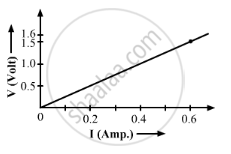Advertisements
Advertisements
प्रश्न
One coulomb charge is equivalent to the charge contained in:
(a) 2.6 × 1019 electrons
(b) 6.2 × 1019 electrons
(c) 2.65 × 1018 electrons
(d) 6.25 × 1018 electrons
उत्तर
6.25 × 1018 electrons
Since the charge of an electron is `1.6xx10^(-19)C` 6.25 × 1018 electrons taken together constitute (6.25 × 1018 × 1.6 × 10−19 C) or 1 coulomb of charge.
APPEARS IN
संबंधित प्रश्न
Which of the following equation shows the correct relationship between electrical unit?
1A = 1C/s or 1c= 1A/s
An electric circuit consisting of a 0.5 m long nichrome wire XY, an ammeter, a voltmeter, four cells of 1.5 V each and a plug key was set up.
Following graph was plotted between V and I values:

What would be the values of `V/I` rations when the potential difference is 0.8 V, 1.2 V and 1.6 V respectively?
What conclusion do you draw from these values?
What is the resistance of the wire?
A p.d. of 6 V is applied to two resistors of 3 Ω and 6 Ω connected in parallel. Calculate:
(a) the combined resistance
(b) the current flowing in the main circuit
(c) the current flowing in the 3 Ω resistor.
If you were going to connect two light bulbs to one battery, would you use a series or a parallel arrangement? Why? Which arrangement takes more current form the batte
A given wire of resistance 1 Ω is stretched to double its length. What will be its new resistance?
State the relation between work, charge and potential difference for an electric circuit.
Tick (✓) the correct choice among the following :
Which of the following changes would enable a millimeter to be used as a
direct current ammeter reading upto 1 A?
Calculate the current through a 60 W lamp rated 250 V. If the line voltage falls to 200 V, how is power consumed by the bulb affected?
Three heaters each rated 250 W, 100 V are connected in parallel to a 100 V supply. The resistance of each heater
